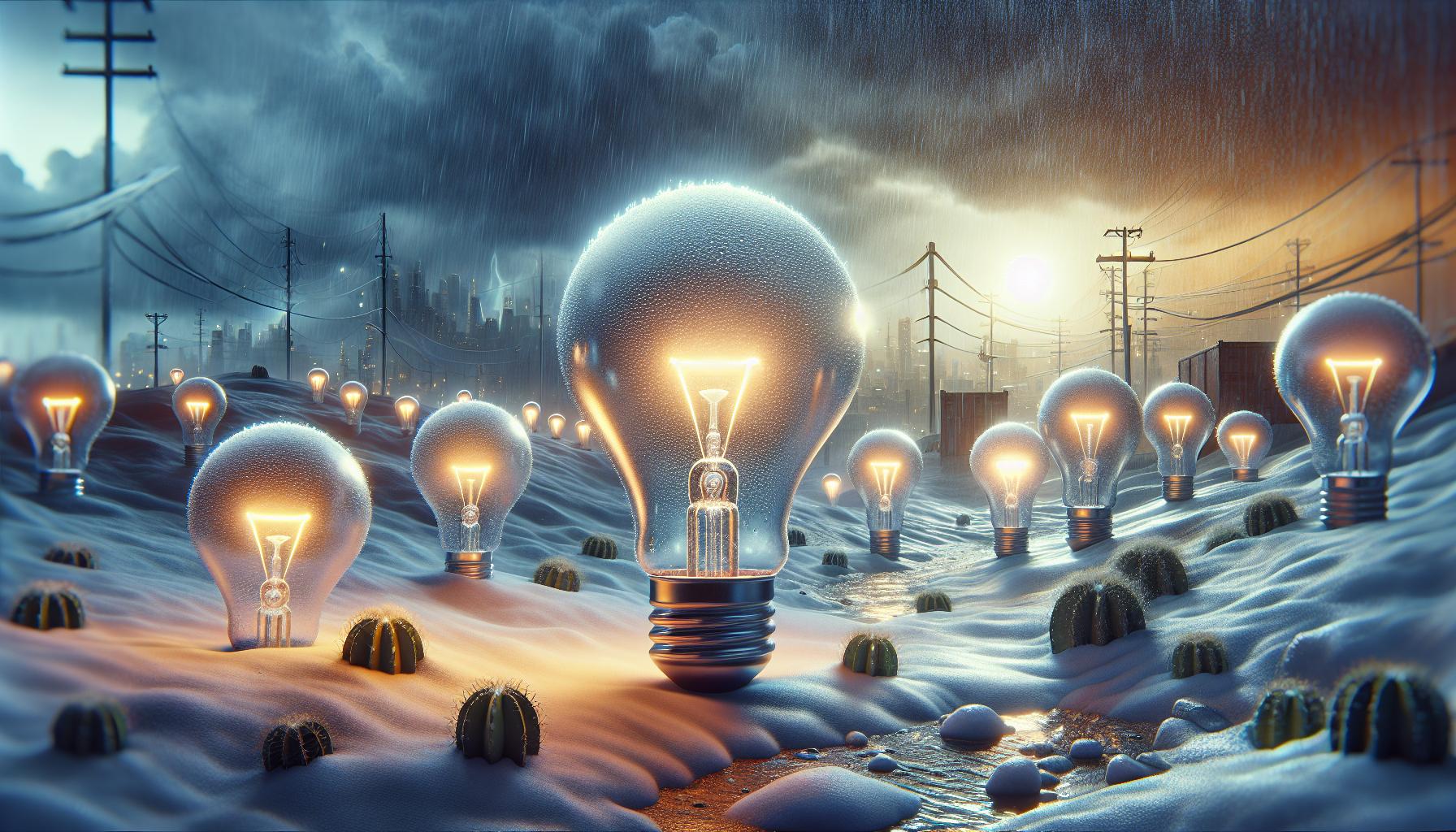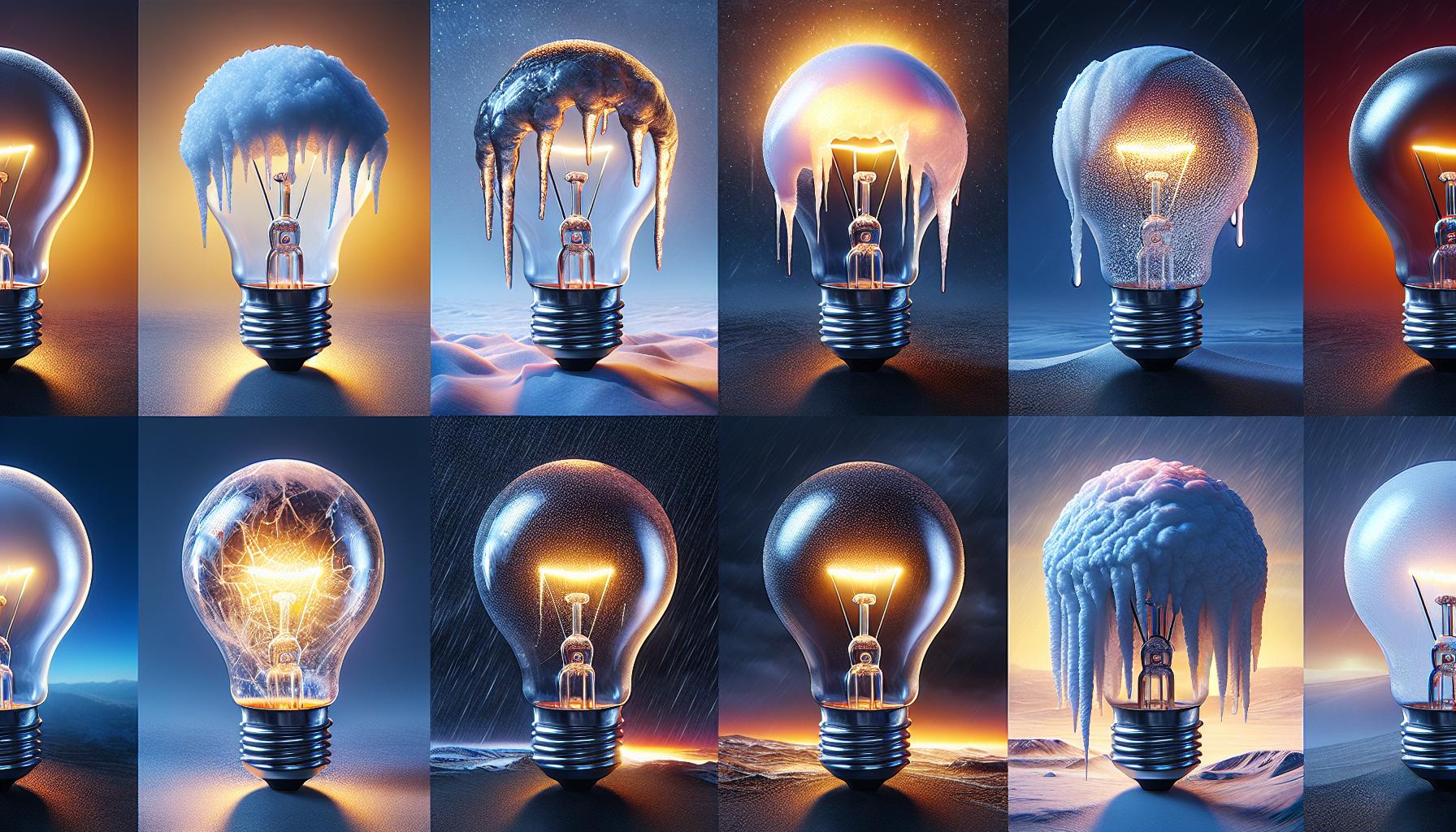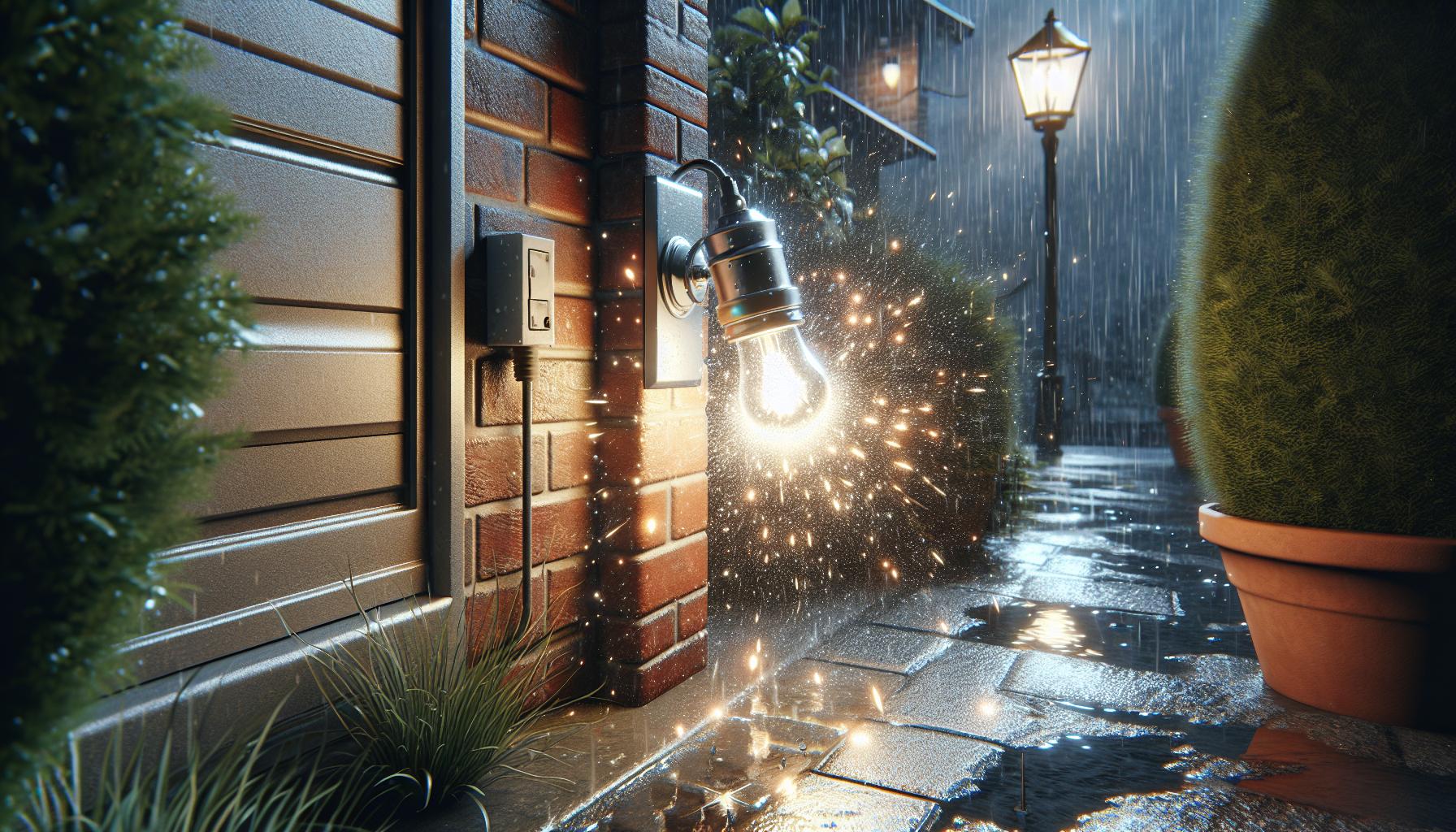Ever wondered if those spare indoor light bulbs could live a second life brightening up your porch or backyard? You’re not alone! It’s tempting to just screw an indoor bulb into an outdoor fixture, especially when you’re in a pinch.
But before you make the swap, it’s worth considering a few key points. Outdoor lighting isn’t just about illumination; it’s about withstanding the elements, too. So, let’s shed some light on whether your indoor bulbs can handle the great outdoors.
Can You Use Indoor Light Bulbs Outside?
Now that you’re pondering whether those spare indoor bulbs could brave your outdoor fixtures, there’s a mix of factors to mull over. Let’s put your mind at ease—or maybe stir up a bit more consideration.
Outdoor lighting fixtures tend to demand a sturdier build to endure the whims of Mother Nature. This isn’t just about rain showers or snow flurries. Think about the full spectrum of outdoor conditions: excessive heat, chilling colds, and even the occasional hailstorm. Your indoor bulbs aren’t designed for that stress test. They might seem fine during a mild evening, but what about mid-summer’s scorching afternoon sun?
- Outdoor Bulbs are usually enclosed and often made of stronger glass or covered by shields.
- Indoor Bulbs might crack or break when exposed to harsh temperatures or wet conditions.
Size is another aspect you’re probably overlooking. Outdoor sockets can differ in size, and while an indoor bulb might physically fit, it might not reflect light as effectively as an outdoor bulb—casting shadows where you need visibility or failing to illuminate the desired area properly.
Safety is an evident concern. If your indoor bulb gives out under the pressure of outdoor use, aside from being left in the dark, you could be dealing with electrical risks or potential fire hazards. Your ideal scenario doesn’t include a bulb explosion at the next backyard BBQ.
Don’t get all gloomy about it; there are always exceptions. LED bulbs are a shining example. Many are built for both indoor and outdoor use, owing to their low heat output and durable designs. If the packaging specifies outdoor compatibility, you might just be in luck. Just remember that wattage and lumens matter:
| Type | Wattage | Lumens |
|---|---|---|
| Indoor LED | 6-9W | 800lm |
| Outdoor LED | 9-13W | 1300lm |
You’ll want ample lumens for outdoor visibility, so don’t just go scaling down wattage because it seems energy efficient. Flip through those specs and know what’s up—or better yet, what’s bright—before making the switch. Afterall, your outdoor space deserves lighting that not only looks good but also holds up to the elements.
Factors to Consider
Before taking the leap and popping an indoor bulb into your outdoor fixture, it’s critical to weigh several factors. The right choice can save you time, money, and potential safety risks down the line.
Weather Resistance
Your first instinct might be to check the weatherproof rating on your indoor bulb, but you’ll often find there isn’t one. Unlike their outdoor counterparts, indoor bulbs aren’t built to fend off the elements. So, consider the type of weather your outdoor fixtures will face:
- The bulb’s ability to handle extreme temperatures
- Water resistance level, especially in areas prone to rain or humidity
- Resistance to dirt and debris that could affect the functionality
Safety Matters
It’s not just about whether the bulb will last but also about how safe it is to use. Indoor bulbs aren’t sealed against moisture, which can lead to electrical shorts. Be mindful of:
- The risk of electrical hazards associated with using non-outdoor rated bulbs
- Potential for fire hazards due to overheating
Efficiency and Cost
Indoor and outdoor bulbs vary in efficiency. With an eye on efficiency, you’ll want to check the bulb’s:
- Energy consumption
- Projected lifespan in outdoor conditions
- Lumen output in relation to outdoor visibility needs
And when it comes down to cost effectiveness, remember that constantly replacing indoor bulbs used outdoors can add up.
Bulb Type Matters
« What Size Light Bulb for Ceramic Christmas Tree: Brighten Up Your Holidays
Are Light Bulbs Universal? The Truth About LED Compatibility »
If you’re considering an LED bulb, you’re on the right track. Many LED bulbs are suitable for both environments due to their construction. Still, double-check their specifications for outdoor use. For non-LED types, it’s best to stick to the manufacturer’s recommendations.
As you plan your outdoor lighting project, keep these considerations in mind. Smart choices early on can prevent headaches and ensure that your outdoor space is both beautifully and safely illuminated.
Resistance to Moisture
When you’re considering lighting up your outdoor space, it’s crucial to understand that moisture is a main adversary for indoor light bulbs. Unlike their outdoor counterparts, indoor bulbs typically lack the necessary seals to prevent water from seeping in. This can cause shorts, reduce bulb life, and even create hazards.
Outdoor bulbs, on the other hand, are designed with robust seals to protect their electrical components from rain, snow, and ambient moisture. It’s like wearing a raincoat in a storm; outdoor bulbs come prepared. So, before you decide to use an indoor bulb outside, ask yourself if you’re ready to risk your safety and the bulb’s functionality.
But here’s a bright spot: some indoor LED bulbs are created with a certain degree of moisture resistance. LEDs generate less heat and are more compact which makes them easier to seal. Look for bulbs that boast an IP (Ingress Protection) rating. These ratings tell you how well the bulb can resist materials like dust and water. The higher the number following ‘IP’, the better. IP65 or higher is what you should aim for in a moisture-prone environment.
Remember that even with moisture-resistant bulbs, the fixtures play a significant role. If your outdoor fixture isn’t sealed effectively, that moisture resistance won’t mean much. When you pair a moisture-resistant bulb with a well-sealed outdoor fixture, you’ve got a combination that’ll keep the lights on even when Mother Nature has other ideas.
- Always check bulb packaging for moisture resistance ratings
- Consider upgrading outdoor fixtures to ensure they offer adequate protection
- Understand that even moisture-resistant bulbs may have a shorter lifespan outdoors due to exposure to the elements
By taking these simple precautions, you’ll illuminate your outdoor spaces effectively while maintaining both safety and efficiency. It’s all part of making well-informed DIY lighting decisions.
Temperature Extremes
When you’re considering repurposing indoor light bulbs for outdoor settings, temperature becomes a critical factor. Indoor bulbs are typically designed to function within the stable, moderate temperatures found inside homes. Outside, they must endure a much wider range of conditions that can be quite extreme.
Extreme cold and heat can greatly affect the performance and longevity of a light bulb. In the cold, traditional incandescent and halogen bulbs can work decently because they generate heat as they light up. However, LED bulbs, while more energy-efficient, may struggle with low temperatures since they don’t produce much heat to withstand the cold.
Here’s a quick rundown on how different bulbs fare in chilly conditions:
- Incandescent bulbs: May work well but their lifespan could be reduced in fluctuating temperatures.
- CFLs (Compact Fluorescent Lights): Often not recommended for cold weather as they take longer to light up and can be dimmer.
- LEDs: High-quality LEDs are better suited for cold temperatures but it’s essential to check if they’re rated for outdoor use.
On the flip side, excessive heat can also present issues. Heat can build up in the enclosed spaces of outdoor fixtures, particularly in the summer months. This trapped heat can cause indoor bulbs to overheat and fail prematurely. While many outdoor bulbs are designed to cope with this build-up, indoor bulbs may not dissipate heat effectively leading to possible malfunctions or even hazards.
Especially for LED bulbs, which are sensitive to heat, make sure the ones you choose are specified for outdoor use and can handle the temperature swings. Products typically mention their operational temperature ranges, and for outdoor use, you’ll want to ensure those ranges align with your local climate extremes.
Remember, temperature isn’t just about comfort; it’s about function and safety. When you’re picking a bulb for outdoor use, think about the environmental conditions it’ll face year-round. Your best bet is to invest in bulbs that are explicitly built for the outdoors — designed not just to endure but to thrive under the roof of the sky with its unpredictable temperament.
Safety Concerns
Before you dart off to retrofit your outdoor fixtures with indoor light bulbs, hold that thought. Safety should be your priority. The design and build of an indoor bulb typically don’t account for outdoor conditions, such as moisture. When moisture seeps into the bulb or its fixture, it’s a swift road to hazards. Short circuits can occur, leading to potential electrical fires – a risk you definitely don’t want looming over your peaceful backyard gatherings.
Bulbs in damp or wet locations outside need to have an appropriate IP (Ingress Protection) rating. This rating tells you whether a light bulb can handle the effects of rain or sprinklers. Indoor bulbs lack these ratings, leaving them vulnerable in unexpected showers or in areas with high humidity. And remember, that’s not just a summer storm concern – think about those foggy mornings too.
Even the wiring in your outdoor lighting setup demands scrutiny. If you’re a DIY enthusiast, you’d know that outdoor and indoor wirings differ. Exterior wiring has additional insulation and protections against the elements. Pairing this with an indoor bulb might seem harmless, but it’s akin to wearing a raincoat over a summer dress in a downpour—you’re not fully protected.
Let’s not forget about pests. Outdoor lights are built to create a seal against small critters that would love nothing more than to nest in a warm light fixture. Indoor bulbs just aren’t cut out for this. Before you know it, you might have a mini-ecosystem thriving right above your porch light.
If you’re considering using indoor bulbs outside, you’ve got to assess all these variables. It’s about more than just getting the illumination right; it’s taking responsibility for your home’s safety. Carefully research the specifications needed for outdoor lighting, and you’ll keep the glow without the worry.
Conclusion
So there you have it! When lighting up your outdoor spaces, it’s crucial to pick the right bulb for the job. Remember, what works inside won’t necessarily cut it outside where the elements reign supreme. Always go for outdoor-specific bulbs that can brave the weather and keep safety hazards at bay. After all, a well-lit patio or garden should bring peace of mind, not cause for concern. Happy lighting!
Frequently Asked Questions
Can indoor light bulbs be used outside safely?
Indoor light bulbs are not recommended for outdoor use due to their lack of design for extreme temperatures, moisture, and other outdoor conditions, leading to potential safety hazards.
What is an IP rating and why is it important for outdoor bulbs?
An IP (Ingress Protection) rating indicates the degree of protection against solids and liquids. A higher IP rating is essential for outdoor bulbs to ensure they can handle damp or wet conditions safely.
Are wiring systems different for indoor and outdoor light fixtures?
Yes, outdoor lighting fixtures generally require different wiring that is suited for exposure to the elements and potential temperature fluctuations, unlike indoor wiring systems.
What happens if pests get into light fixtures that are not designed for outdoor use?
Pests can nest in light fixtures not built for outdoors, causing damage or creating a fire hazard. It is important to choose fixtures specifically designed to prevent this problem.
Why is it important to research bulbs made for outdoor use?
Researching and choosing light bulbs designed for outdoor use is crucial as they are built to cope with outdoor conditions, ensuring safety and longevity of your lighting setup.





